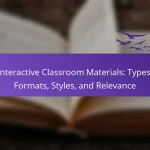Nonprofits looking to enhance their educational initiatives can find a wealth of affordable interactive classroom materials that foster engagement and collaboration among students. By utilizing free resources available through various platforms, these organizations can transform traditional lessons into dynamic learning experiences without straining their budgets.

What are the best affordable interactive classroom materials for nonprofits?
Nonprofits seeking interactive classroom materials can benefit from a variety of affordable resources that enhance learning experiences. These tools promote engagement and collaboration while remaining budget-friendly, making them ideal for educational initiatives.
Nearpod interactive lessons
Nearpod offers a platform for creating interactive lessons that engage students through multimedia presentations, quizzes, and polls. Nonprofits can access a free version with limited features or opt for affordable pricing plans that unlock additional functionalities.
To maximize its use, consider integrating Nearpod lessons with existing curricula. This can help maintain student interest and facilitate real-time feedback, allowing educators to adjust their teaching strategies based on student responses.
Google Slides templates
Google Slides provides customizable templates that nonprofits can use to create visually appealing presentations and interactive activities. These templates are free and can be easily shared with students, making collaboration seamless.
When using Google Slides, focus on incorporating interactive elements such as hyperlinks and embedded videos to enhance engagement. Additionally, consider utilizing Google’s extensive library of add-ons to further enrich your presentations.
Canva educational resources
Canva offers a wide range of educational resources, including infographics, posters, and worksheets that nonprofits can use to create engaging classroom materials. Many of these resources are free, while premium options are available at a low cost.
To effectively use Canva, leverage its user-friendly design tools to create visually striking materials that align with your educational goals. Encourage students to participate in the creation process, fostering creativity and ownership of their learning.
Classroom screen tools
Classroom screen tools provide a digital space for displaying instructions, timers, and student work, which can enhance classroom management. Many of these tools are free or have low-cost options, making them accessible for nonprofits.
Utilize features like customizable backgrounds and widgets to create a dynamic learning environment. Be mindful of not overcrowding the screen, as clarity and simplicity are key to maintaining student focus.
Flipgrid video discussions
Flipgrid is a video discussion platform that allows students to share their thoughts and ideas through short video responses. This tool is free for educators and can foster a sense of community among students, even in remote settings.
To effectively implement Flipgrid, set clear guidelines for video responses and encourage peer feedback. This can enhance critical thinking and communication skills, making it a valuable addition to any interactive classroom experience.
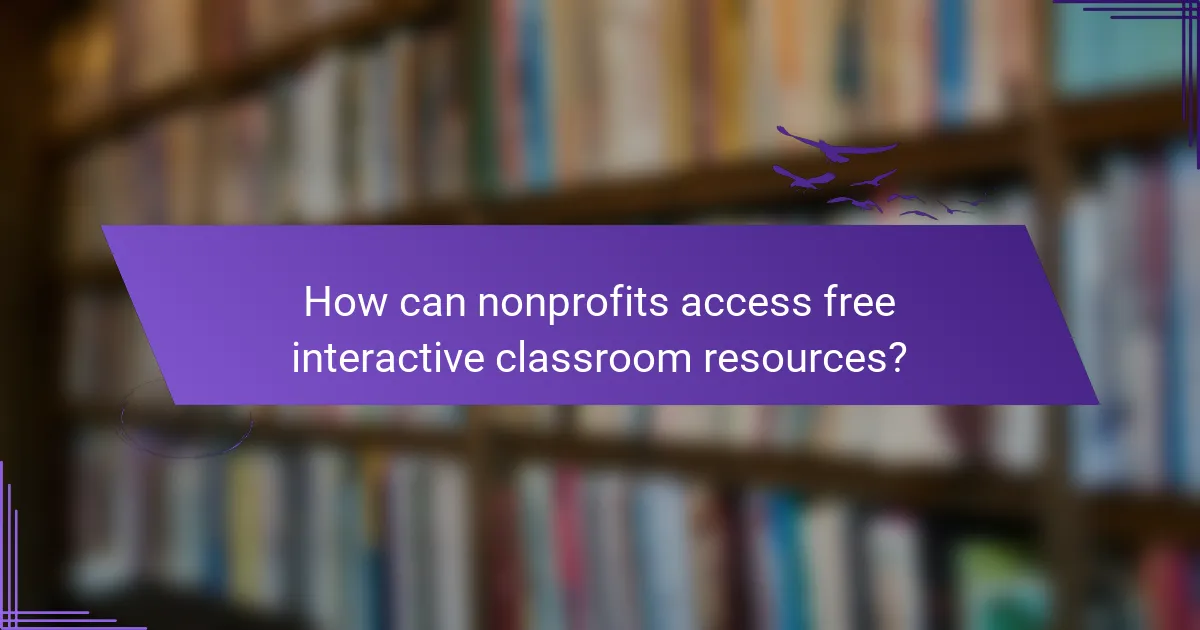
How can nonprofits access free interactive classroom resources?
Nonprofits can access free interactive classroom resources through various platforms and initiatives designed to support educational efforts. These resources often include digital materials that enhance learning experiences without incurring costs.
Open Educational Resources (OER)
Open Educational Resources (OER) are teaching, learning, and research materials that are freely available for anyone to use. Nonprofits can find OER in the form of textbooks, lesson plans, and multimedia content that can be adapted to their specific needs.
To effectively utilize OER, nonprofits should explore platforms like OER Commons and OpenStax, which provide a wide range of materials across different subjects. It’s essential to verify the licensing of each resource to ensure compliance with usage rights.
Creative Commons licensed materials
Creative Commons licensed materials allow nonprofits to use, share, and adapt content legally, often at no cost. These materials can include images, videos, and educational resources that enhance classroom engagement.
When searching for Creative Commons content, websites like Flickr, Wikimedia Commons, and Google Images offer filters to find materials that are free to use. Nonprofits should pay attention to the specific license type, as some may require attribution or restrict commercial use.
Nonprofit grants for educational tools
Nonprofits can apply for grants specifically aimed at acquiring educational tools and resources. Many foundations and government programs offer funding opportunities that can help cover costs associated with interactive classroom materials.
To identify suitable grants, nonprofits should research local and national funding sources, such as the U.S. Department of Education or private foundations like the Bill & Melinda Gates Foundation. Preparing a clear proposal that outlines the intended use of the funds can significantly increase the chances of securing financial support.
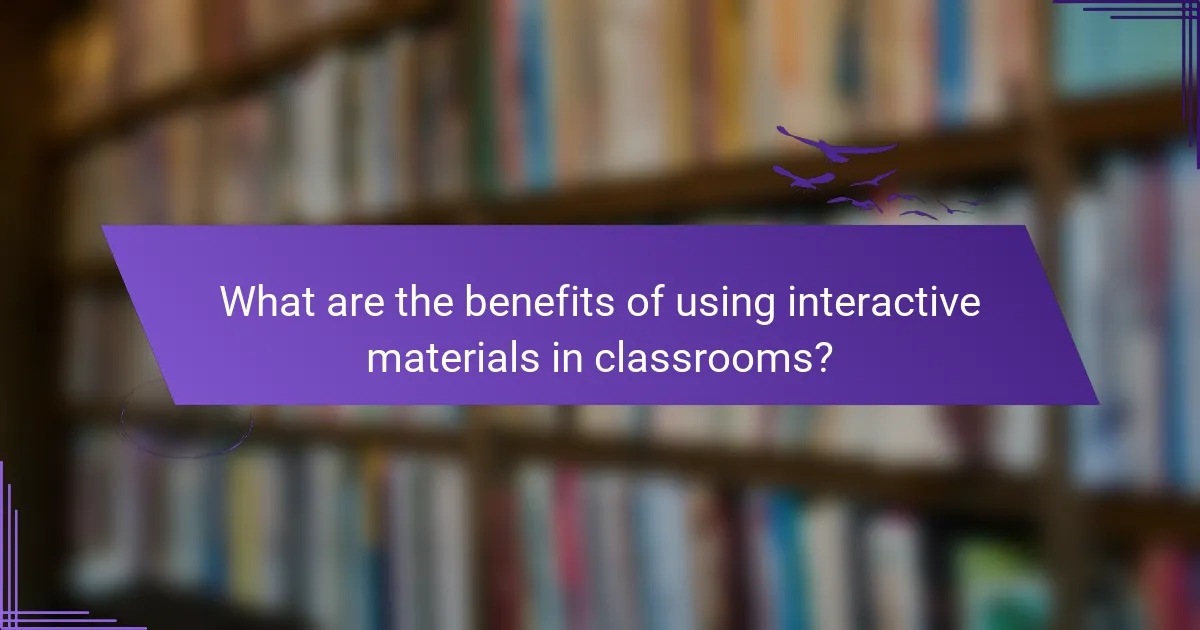
What are the benefits of using interactive materials in classrooms?
Interactive materials in classrooms enhance the learning experience by actively engaging students, improving retention, and fostering collaboration. These resources can transform traditional lessons into dynamic activities that motivate learners and promote deeper understanding.
Enhanced student engagement
Interactive materials capture students’ attention and make learning enjoyable. By incorporating elements like quizzes, games, and simulations, educators can create a stimulating environment that encourages participation. For example, using digital tools like Kahoot or Quizlet can turn assessments into fun competitions.
To maximize engagement, consider using a variety of formats that cater to different learning styles. Visual aids, hands-on activities, and group projects can all contribute to a more engaging classroom experience.
Improved learning outcomes
Utilizing interactive materials can lead to better learning outcomes by promoting active participation and critical thinking. Research suggests that students who engage with interactive content often retain information more effectively than those who rely solely on traditional methods.
To enhance learning outcomes, focus on aligning interactive activities with curriculum goals. For instance, using case studies in a social studies class can help students apply theoretical concepts to real-world situations, reinforcing their understanding.
Facilitated collaboration
Interactive materials encourage collaboration among students, fostering teamwork and communication skills. Group activities, such as collaborative projects or peer reviews, allow learners to share ideas and learn from one another, which is vital in today’s interconnected world.
To facilitate collaboration, implement tools that support group work, such as Google Docs or online discussion boards. These platforms enable students to collaborate in real-time, regardless of their physical location, making it easier to work together effectively.
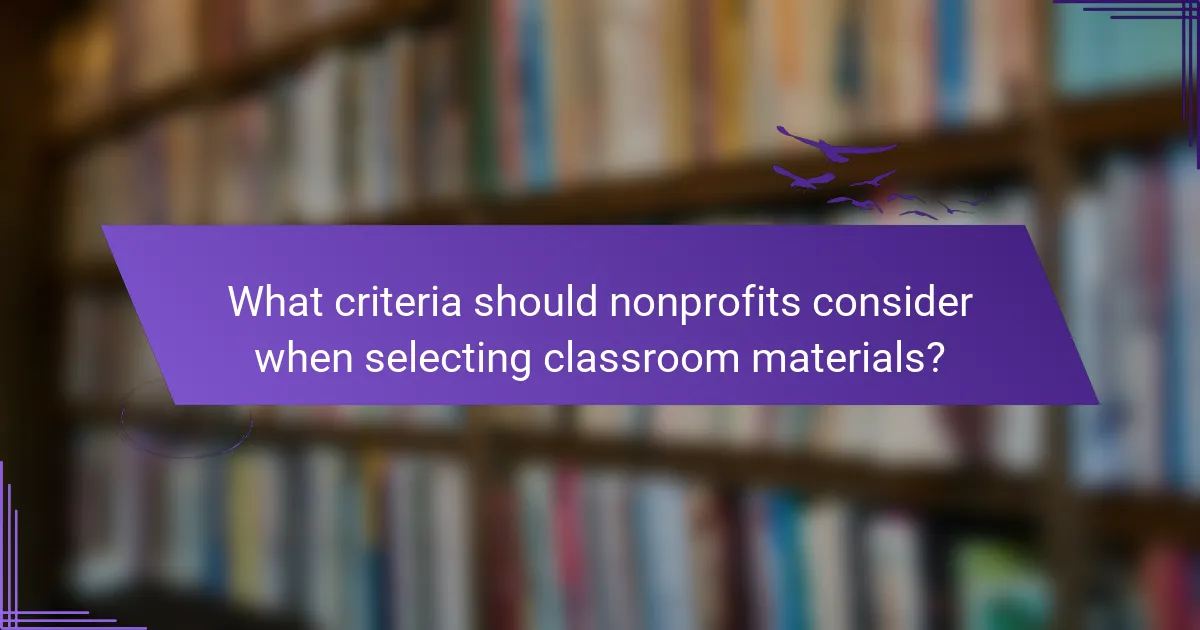
What criteria should nonprofits consider when selecting classroom materials?
Nonprofits should prioritize affordability, alignment with educational goals, and usability when selecting classroom materials. These criteria ensure that resources are effective and accessible, maximizing the impact of educational programs.
Budget constraints
Budget constraints are a primary concern for nonprofits, as funding is often limited. It’s essential to evaluate the total cost of materials, including any hidden fees such as shipping or taxes. Aim for resources that provide the best value, balancing quality and affordability.
Consider exploring bulk purchasing options or discounts for nonprofits, which can significantly reduce costs. Many suppliers offer special pricing for educational institutions, so inquire about these opportunities to stretch your budget further.
Alignment with learning objectives
Selecting materials that align with specific learning objectives is crucial for effective education. Ensure that the resources support the curriculum and meet the needs of the students. This alignment enhances engagement and learning outcomes.
Review state or national educational standards relevant to your programs. Choose materials that not only meet these standards but also cater to diverse learning styles, ensuring inclusivity and effectiveness in teaching.
Ease of use for educators
Materials should be user-friendly for educators, allowing for easy implementation in the classroom. Consider the time required for preparation and the complexity of the resources. Simple, straightforward materials can save educators valuable time and effort.
Provide training or support for educators to maximize the effectiveness of the materials. This could include workshops or online resources that help teachers integrate the materials into their lessons seamlessly.
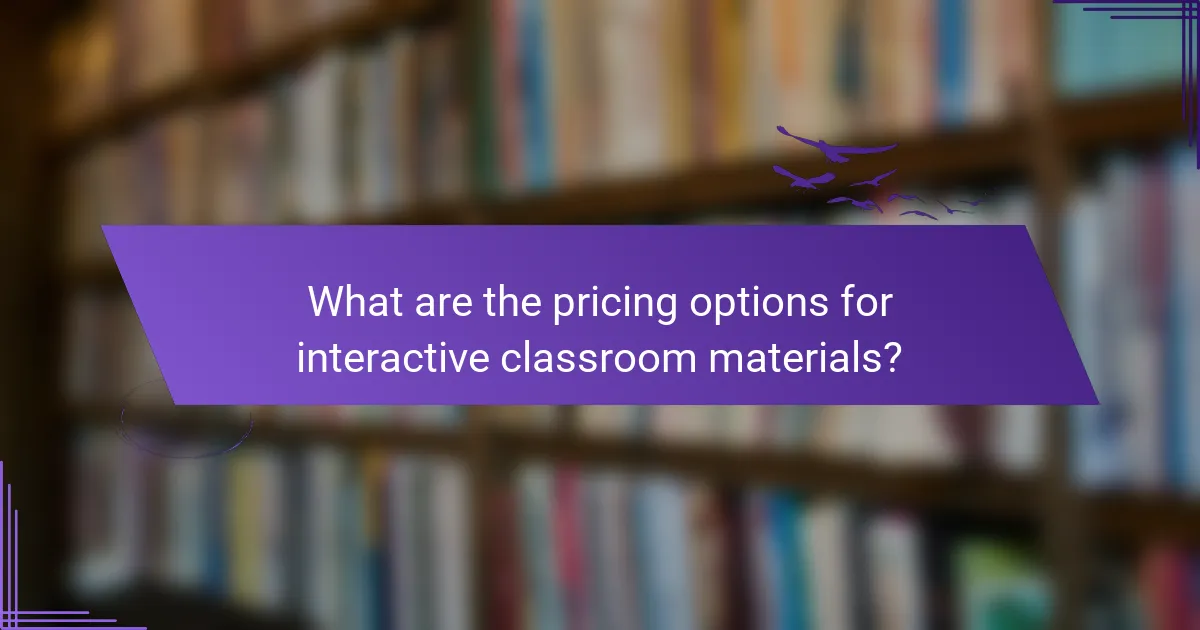
What are the pricing options for interactive classroom materials?
Interactive classroom materials come with various pricing options to accommodate different budgets, especially for nonprofits. These options include subscription-based services, one-time purchases, and freemium models, each with its own advantages and considerations.
Subscription-based services
Subscription-based services typically charge a recurring fee, often monthly or annually, granting access to a range of interactive materials. This model can be cost-effective for organizations that need ongoing resources, as it often includes updates and new content.
Prices for subscriptions can vary widely, generally ranging from around $10 to $50 per month, depending on the provider and the features included. Nonprofits should evaluate the total cost against their usage to determine if this model suits their needs.
One-time purchase models
One-time purchase models allow organizations to buy specific interactive materials outright, providing permanent access without recurring fees. This option can be beneficial for nonprofits with limited budgets that prefer to make a single investment rather than ongoing payments.
Prices for one-time purchases can range from $20 to several hundred dollars, depending on the complexity and scope of the materials. Nonprofits should consider the longevity and relevance of the content when opting for this model.
Freemium options
Freemium options offer basic interactive materials at no cost, with the possibility to upgrade to premium features for a fee. This model is particularly advantageous for nonprofits that want to test resources before committing financially.
While freemium models can provide valuable resources for free, nonprofits should be cautious of limitations in functionality or content. Upgrading to premium versions can range from $5 to $100, depending on the additional features desired.


